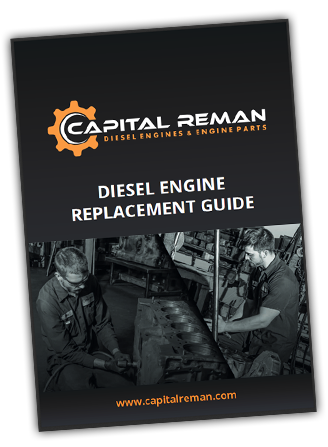Cummins Unveils 90% NOx Emission Reduction Engine
 Since the inception of the EPA Tier Regulations in 1994 diesel engine manufactures have made tremendous strides into making diesel engines more environmentally friendly. Cummins recently introduced a new natural gas engine that produces a near zero amount of emissions. The commercial truck and bus engines is seven years ahead of the ultra-low emissions schedule enacted by the EPA.
Since the inception of the EPA Tier Regulations in 1994 diesel engine manufactures have made tremendous strides into making diesel engines more environmentally friendly. Cummins recently introduced a new natural gas engine that produces a near zero amount of emissions. The commercial truck and bus engines is seven years ahead of the ultra-low emissions schedule enacted by the EPA.
Cummins Inc. teamed up with natural gas developer Westport Inc. to form Cummins Westport Inc. as a joint venture. The new Zero-NOx engine is an 8.9L beast which is scheduled for debut at the end of 2016 and set for mass production starting in 2017. The engine is finishing up field testing this year and the company is already taking orders upon successful completion of the last phase of testing. The engine will be called the ISL G NZ (near zero) and will help trucking companies meet regulations set by the Environmental Protection Agency Tier Rating Phases from 2023 through 2031. Introducing the engine ahead of schedule will give many companies a head start on meeting the much tougher regulations which are forthcoming. Cummins is also working on the near zero models for the ISX 12L and the ISB 6.7L. The technology is a gamechanger for those both on the environmental protection side as well as fleet owners seeking an opportunity to convert older fleets from diesel to natural gas.
The current EPA limit for greenhouse gasses is 0.2 g/bph-hr. The ISL G NZ engine cuts emissions by 90% compared to current natural gas engines on the market. Nitrogen Oxide (NOx) is the main emissions byproduct of combustion engines and is a prime pollutant of smog and harmful ozone particulate. The emissions from the Cummins Westport ISL are equivalent to that of a truck or bus powered by an electrical engine. Conversion of older bus and truck fleets will be quite costly initially but necessary in order to meet or exceed the EPA regulations. However, the environmental benefits are substantial. For example, Los Angeles has a fleet of 2,250 transit buses. Converting those buses to clean natural gas engines would result in a fleet that produces as much emissions as two buses in 1985. Natural gas is also cheaper than diesel fuel and in more abundant supply than diesel fuel resulting in significant fuel savings in the long-run.
EPA and California Air Resources Certified
 The Cummins ISL Near Zero is the first engine to receive emissions certifications from the EPA and California Air Resources Board for producing just 0.02 g/bph-hr of NOx per horsepower hour. The Cummins ISL G NZ also meets current greenhouse gas emissions with a 9% reduction in emissions from the current ISL G (Natural Gas Model). For engines operating on renewable natural gas (RNG), greenhouse gasses may be further reduced. The Near Zero engine has been described by the California Air Resources Board (CARB) as being the equivalent to a 100% battery truck using electricity from a modern combined cycle natural gas power plant. The board has been a big proponent and backer of zero emission technology and given incentives to Cummins Westport for development of the technology.
The Cummins ISL Near Zero is the first engine to receive emissions certifications from the EPA and California Air Resources Board for producing just 0.02 g/bph-hr of NOx per horsepower hour. The Cummins ISL G NZ also meets current greenhouse gas emissions with a 9% reduction in emissions from the current ISL G (Natural Gas Model). For engines operating on renewable natural gas (RNG), greenhouse gasses may be further reduced. The Near Zero engine has been described by the California Air Resources Board (CARB) as being the equivalent to a 100% battery truck using electricity from a modern combined cycle natural gas power plant. The board has been a big proponent and backer of zero emission technology and given incentives to Cummins Westport for development of the technology.
Nitrogen Dioxide is hard to remove from diesel engines. Current technology includes post exhaust (Diesel Particulate Filters) and (Diesel Exhaust Fluid) which have limited success at reducing emissions but not eliminating them all together. Removing emissions from diesel engines is serious business, just ask the engineers at Volkswagen who resorted to fabricating NOx data to meet U.S. EPA Standards. The company was caught red-handed and faced billions of dollars in expenses, federal and state fines and plummeting sales to bring all engines up to compliance.
The correct emission technology has been available for many years and EPA Tier Regulations were enacted in stages to give companies the chance to over time become compliant. VW simply didn’t want to spend the extra cost to build engines with sufficient filtration exhaust equipment. Now they are paying the price for it.
Cummins took a proactive approach by installing the appropriate filtration systems on all of its new engines and has now been the first on the block of the big diesel manufacturers (Caterpillar, Cummins, Detroit Diesel, John Deere, International, Mack) to introduce Near Zero NOx technology.
The Cummins team decided to implement the Near Zero emission technology with a natural gas engine versus a diesel engine. Natural gas engines naturally produce lower NOx than diesel engines and the engineering team used that as a starting point to remove even more noxious particulate from the exhaust stream. The ISL G NZ features stoichiometric cooled exhaust gas recirculation (SEGR) combustion technology, spark ignition and simple TWC after-treatment as the standard natural gas engine. Additionally the engine features two brand new emissions technologies: Three-Way Catalyst and Close Crankshaft Ventilation.
New Emissions Engineering Technology in the Cummins ISL G NZ Engine
 Three-Way Catalyst aftercooler technology is a passive device which is highly effective at hydrocarbon control of CO and NOx with no additional maintenance costs. No standard diesel particulate filter or selective catalytic reduction systems are required. The ISL G NZ catalyst includes a mid-catalyst temperature sensor connected to the ECM. Close Crankshaft Ventilation is a chassis mounted system that prevents crankcase emissions generated by the engine during normal operation. The technology works by capturing crankcase emissions and redirecting them through the close crankshaft ventilation filter where oil is removed before sending the gases back into the intake manifold to be re-introduced to the combustion chamber. This reduces engine related methane gas emissions by more than 75%.
Three-Way Catalyst aftercooler technology is a passive device which is highly effective at hydrocarbon control of CO and NOx with no additional maintenance costs. No standard diesel particulate filter or selective catalytic reduction systems are required. The ISL G NZ catalyst includes a mid-catalyst temperature sensor connected to the ECM. Close Crankshaft Ventilation is a chassis mounted system that prevents crankcase emissions generated by the engine during normal operation. The technology works by capturing crankcase emissions and redirecting them through the close crankshaft ventilation filter where oil is removed before sending the gases back into the intake manifold to be re-introduced to the combustion chamber. This reduces engine related methane gas emissions by more than 75%.
The downside of a near zero emissions engine is that the cost is likely 10% to 15% more than an equivalently equipped diesel bus. If you are a fleet owner with hundreds of buses that cost can add up a lot. However, help is on the way; in California the Air Resources Board recently added $2 million to its HVIP hybrid and electric bus voucher program for low NOx engine purchase incentives. The board hopes to boost that number to $23 million for the 2016-17 budgetary year. In the long run, this technology will be integrated into all new engines and the price will become lower for fleet owners.
Cummins 8.9L ISL G NZ Specifications:Horsepower: 320 HP
Electrical Output Rating: 230 kW
Peak Torque: 1000 lb-ft
Governed Speed: 2,200 RPM
Clutch Engagement Torque: 550 lb-ft Type: 4 Cycle, Spark Ignited, Inline 6-Cylinder, Turbocharged, CAC
Type: 4 Cycle, Spark Ignited, Inline 6-Cylinder, Turbocharged, CAC
Displacement: 540 cu. in.
Bore and Stroke: 4.49 in. x 5.69 in.
Operating Cycle: 4
Oil System Capacity: 7.3 U.S. Gal
Coolant Capacity: 13.1 U.S. Qts
System Voltage: 12 V
Net Weight w/Std. Accessories Dry: 1,625 lbs.
Aftertreatment: Three-Way Catalyst
Fuel Types: CNG / LNG / Biomethane. Methane number 75 or greater




